In part one of this two part introduction to EM Records, I’d like to present the path of a music maniac from curiosity to fascination, in its timeline and why this label is so important to Osaka. As important as 4AD is to the UK, ESP Disk is to the USA, Elenco is to Brasil …
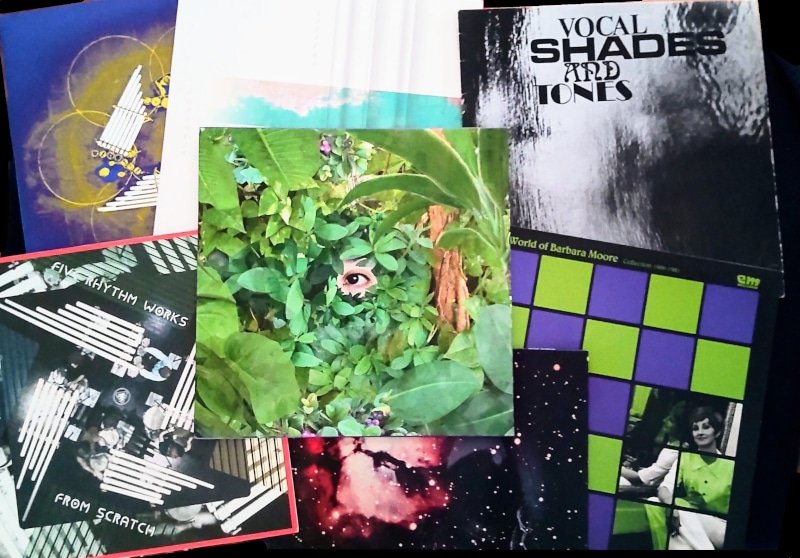
Every music maniac, has their own psychopathically twisting and turning journey through the audible universe. Some people allow their listening to be controlled completely by algorithms, some by DJs, and others by trusted friends, without much thought about the process. Most of us have a mixture of these and more and, for some, music is potatoes or worse.
For most people, their musical curiosity probably peaks in the teenage years and early twenties, when they have plenty of time to relax and a bit of pocket money. Then real life begins. But for some of us, the curiosity never ends. We call ourselves music lovers, but more realistically we are music addicts/maniacs and our addiction/curiosity never dissipates. We’re always hunting for our next fix. Some of us are are makers, some are listeners and some are curators. Active and passive. Consumer, consumed, consommé.
I’m on a search for the music maniacs of Osaka. Some will be musicians, some will be diggers, and some will be record label owners. I’m hoping to find out more about my mania, and those of others.
This month and next, I’m focusing on a label, whose business is based in the heart of Minami in Osaka, where it may seem like all the action happens.
Some record label owners are gold diggers with blunt spades, and some are super-enthusiatic music lovers with no business acumen, but I’d like to introduce you this month to a man who is a digger of 4-leaf clovers with a gentle patient trowel, who experienced a life-changing event, which may partially explain his transition from the former to the latter. Read on if you’d like to know what kind of life event transforms one of us human animals in that way, and to find out more secrets about the most fascinating music label in Osaka.
The record label owner I’m talking about is Koki Emura, the owner of Emura Records. He started his label in 1998 and is, this year, celebrating its 25th anniversary, so a perfect moment to chart its path to becoming a label beloved by many.
Next month I’ll be talking to Emura himself, but this month, I’d like to detail my downfall as I fell under the spell of EM Records in 10 fatal steps:
Table of Contents
Barbara Moore “Vocal Shades & Tones” EM Records EM1023LP reissued 2001
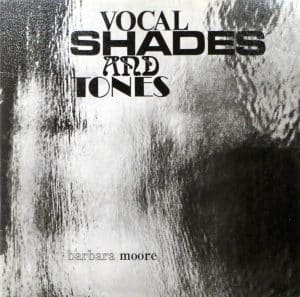
I first encountered the label while rummaging around in Disk Union, where I stumbled upon the 2001 Em Records reissue of Barbara Moore‘s Vocal Shades And Tones, originally issued on the U.K. based library music publisher Music De Wolfe label in 1972. I’d been played this album by a fellow music maniac in London and immediately fell in love with it. I had no idea that an Osaka based label had reissued it, but I snapped it up. I looked at the information on the label, and thought not much more about it.
The Barbara Moore Sound – Hot Heels – From “Vocal Shades & Tones” EM Records EM1023LP 2005 reissue
https://www.youtube.com/watch?v=HlvmD9TAAC0
Barbara Moore “The World Of Barbara Moore Collection 1966-1981” EM Records EM1025DLP released 2001
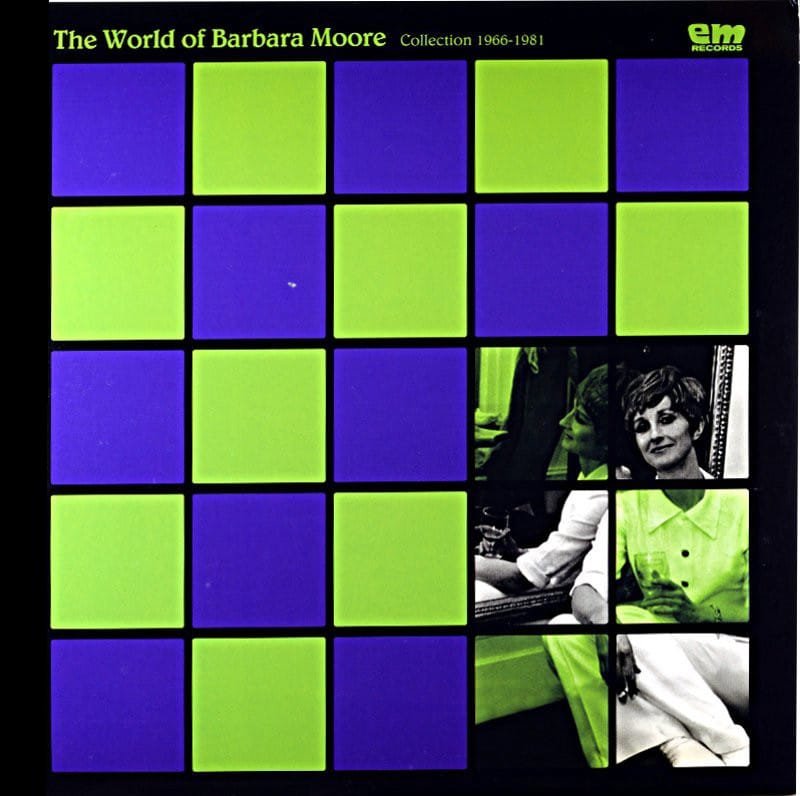
Then a couple of years and a few hundred albums later, I found another Barbara Moore album “The World Of Barbara Moore – Collection 1966-1981” EM Records EM1025DLP, but this time, not a re-issue, but a compilation of sorts, but with tracks exclusive to the release, including a completely previously unreleased suite filling up the whole of side D, “The Music For “Urban Chaos” Film” that I realise in hindsight hinted at the label’s dedication to digging deeper. How could a label in Osaka, Japan be issuing music that hadn’t even been issued in the musician’s own country? It started to make me more and more curious.
Barbara Moore excerpt from the soundtrack to “Urban Chaos”
https://youtu.be/4pBAFgmQWq0
You’re starting to think I only buy records by Barbara Moore, aren’t you? Nothing could be further from the truth … I buy LPs by any artist whose name rhymes with “Corregidor”.
Roland Young “Isophonic Boogie” Woogie EM Records EM1045LP reissued 2005
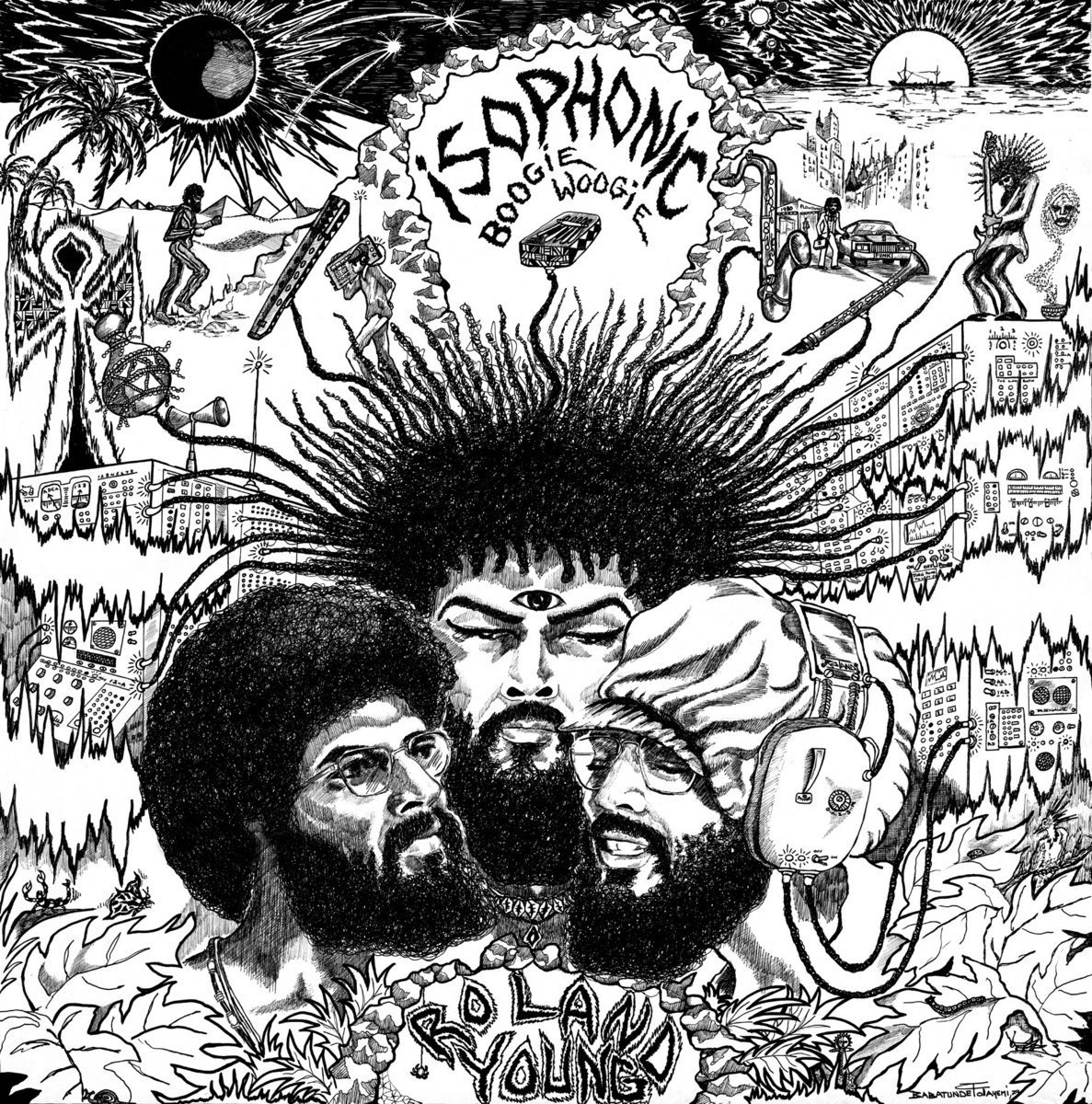
The same year I happened upon another EM Records reissue, this time of the musician Roland Young: The fantastically named Isophonic Boogie Woogie. The cover is a striking black and white drawing, reminiscent to me of the artwork of Fela Kuti albums of the 1970s. The music is rather more difficult to describe, opening with what sounds like a chorus of thumb pianos/ mbiras. Listening tonight, it’s not what I remember at all from my first listen 5 years ago, which of course is one of the pleasures/confusions of music. Time, place, feeling, weather, everything contributes to the enjoyment or otherwise. This album was the beginning of a decades long relationship between EM Records and Roland Young which we’ll learn more about later. This album doesn’t give me the shivers, but it’s certainly a very pleasant experience.
Roland Young “Velvet Dream” from “Isophonic Boogie Woogie” EM Records 2005 reissue
https://emrecords.bandcamp.com/track/velvet-dream
Matsuo Ohno “I Saw The Outer Limits” EM Records reissued 2005

The third album that reeled me in was Matsuo Ohno “I Saw The Outer Limits” originally issued in 1978 under the amusing title “Space And Maryjuane Trip Is Same” reissued by EM Records in 2011 with an extravagant sleeve with a beautiful 3D etched pattern, which changes when moved around in light: a delight to hold and play with.
Matsuo Ohno was the well-respected musician who designed the sound effects for the Astro Boy animated series in the 1970s. “I Saw The Outer Limits” is an album you can listen to and erase your ego, which I like to do on a regular basis.
Ever since I was a child, listening to the music produced by Delia Derbyshire & the BBC Radiophonic Workshop for Dr. Who amongst others, while sniffing the dust burning on the valves of my His Masters Voice portable, I was fascinated by what I still call “science fiction music” when talking to myself, often produced by 1st generation synthesizers or custom made electronic instruments. Melody often totally optional, as in the masterpiece “Forbidden Planet” by Louis & Bebe Baron in the late 50s! Now that is a masterpiece.
“I Saw The Outer Limits” was recorded by Ohno using instruments including a Synth AKS, three Roland System 100s and a custom-made synthesizer. It’s the perfect music for meditation, a planetarium visit or for a home trip, by which I mean, travelling back to your home town in the country, of course.
Matsuo Ohno “I Saw The Outer Limits” EM Records EM1098LP reissue 2011
https://www.youtube.com/watch?v=K4bG3EArBKA
After that I came across Osaka band Goat by hearing a performance of one of the members at a disused biscuit factory …
Goat “New Games / Rhythm & Sound” EM Records EM1170LP reissued 2018
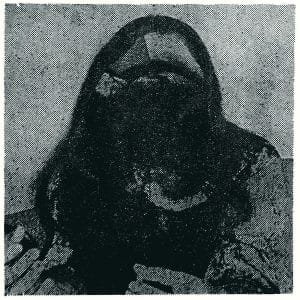
Goat, whose music contains no melodies, well, none in the conventional sense, rather a devotion to rhythm and polyrhythm, are an endlessly fascinating band to me. As I listen to the rhythms played by each member, and my brain tries to make sense of all of them, and fails, I feel I have no option but to surrender and enter a hypnotic state. This is seriously infectious music for dancing with the brain or the body. It’s a kind of funk, but not one that you’ll have heard before. More like the skeleton of funk, after the flesh has been disposed of. Rhythm reduced to its functional, essential parts.Their music also employs elements of dub, efficiently and sparingly. Despite them being, or having been, an Osaka band, I’ve never managed to see them live yet, although they played a 10 year anniversary gig recently.
Their first 2 releases were compiled on the 2018 EM Records release:
https://emrecords.bandcamp.com/album/new-games-rhythm-sound-2
Goat also took part in one of EM Records re-recording/re-realization projects:
Various “8,9,10” And “9,10,11” From Gung Ho 1,2,3D EM Records EM1160DLP released 2017
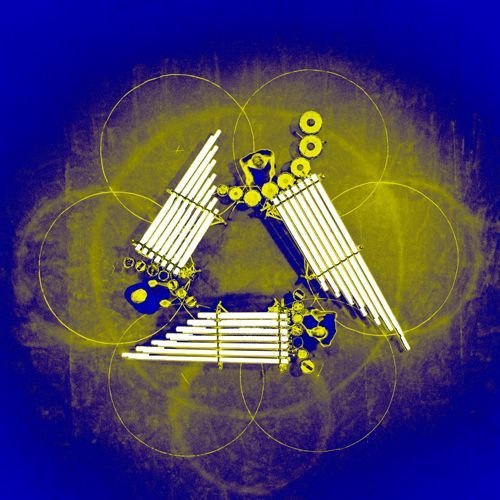
This release sees New Zealand collective From Scratch come face to face with Goat, Don’t DJ and Utena Kobayashi Group as the latter three units re-interpret, not cover or remix, the tracks “8, 9, 10” And “9, 10, 11” from From Scratch’s Gung Ho 1, 2 ,3D album from 1988. This is of course a normal practice in the classical music world, and to do cover versions in the world of rock and pop is nothing new, but this feels like more of an exploration of the originals rather than pure hommage.
Goat are perfectly poised to give their own take on the tracks, well executed, but perhaps too faithful. Don’t DJ produce a very metronomic 200 BPM version which appears to go nowhere in particular. Utena Kobayashi Group’s take is altogether more interesting, using looped sampled voices accompanying the percussion. Recommended for newcomers to EM records, as it showcases many facets of the label, uniting musicans from different continents. Also, as of the writing of this article in October 2023, it can be picked up for an extremely reasonable price second hand.
Utena Kobayashi Group “8,9,10” and “9,10,11” from Gung Ho 1,2,3D:
https://emrecords.bandcamp.com/album/8910-and-91011-from-gung-ho-123d-123d
Synth Sisters Euphoria LP EM Records EM1175LP released 2018

From Osaka, Synth sisters is the duo of MAYUKo and Rie Lambdoll, a side project of their more beats-oriented Crossbred project. This is seriously chilled electronic music perfect for 2 a.m. on chilly autumn nights, walking from Amagasaki to Juso, with this soundtrack to put some fuel in your metaphorical tank. After some sparse vocals on the first track, the rest of the album leaves the music to speak for itself.
Check out the opening track, “w/o/n/d/e/r/f/u/l”:
https://www.youtube.com/watch?v=aXt9kfj4OLo&t=1s
Banyen Rakkaen “Lam Phloen World-class: The Essential Banyen Rakkaen” EM Records EM1174LP released 2018

I’m very fond of 60s and 70s music from Thailand, Cambodia and Vietnam so I was delighted to find that Emura is also a big fan, and prepared to stump up the dough to do do proper licensed releases so the writers, musicians and producers get paid properly. When I first moved to Japan, I found that many of the Japanese recordings from the 1960s lacked the raw excitement of recordings from those other countries and found my kicks from singers like Hoàng Oanh (Vietnam), Sinn Sisamouth (Cambodia) and Bing Slamet (Indonesia).
This album by Thai singer Banyen Rakkaen, known as the “Queen of mor lam”, is particularly thrilling, as it constantly surprises my western ears with content that would seem incongruous in the west, but it’s refreshing to have those preconceptions and expectations continuously confounded and exceeded. “Lam phloen” in the title below describes the style of the song, listerally “joyful singing”, originating in the 1950s, but also popular up until the 1970s when this was recorded and thereafter.
My favourite track from the album: Lam Phloen I Don’t Love You
https://emrecords.bandcamp.com/track/lam-phloen-mai-rak-mai-care-lam-phloen-i-don-t-love-you
Sheriff Lindo “Ten Dubs That Shook The World” EM Records EM1049LP reissued 2005

If you’re a dub reggae fan you definitely need to have a listen to Sheriff Lindo And The Hammer – “Ten Dubs That Shook The World” originally released in Australia in 1988. The dub project of Australian electronic music producer Anthony Maher. These are very well constructed/deconstructed dubs by a serious and passionate dub professor. I can feel his love of the genre as he plays with delays and reverbs on a level to rival the old masters. The ideas never run out. With dub, that’s essential. Nerd fact: The mastering was done by Tom Ellard of the magnificent Severed Heads.
Check out “Fatal Dub” below for a personal favourite:
https://emrecords.bandcamp.com/track/fatal-dub
Mari Sekine “Beginning” EM Records EM1182TEP released 2018
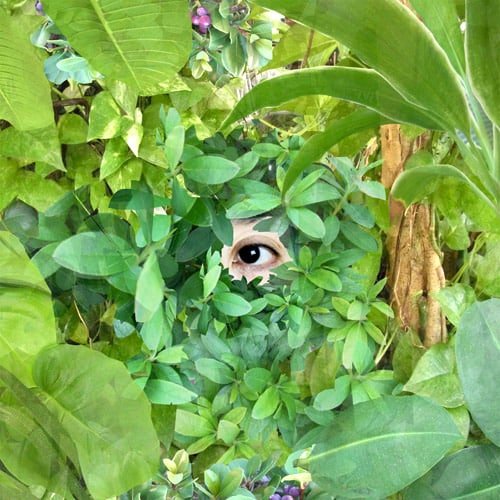
Lastly my current favourite from the label, a 10 minute percussion travelog by expert percussionist Mari Sekine. All the instruments (more than 15 of them, including what sounds like m’bira and deep rich xylophone) were played by Sekine, whose dayjob is providing music for theatre productions. Occasionally reminiscent of the Japanese Queen of ambient, Midori Takada (of “Through the Looking Glass” fame), but displaying her own very special character and composition talents, this track sounds different every time I hear it, causing me to examine the record carefully to confirm that there wasn’t a double groove.
Here’s “Beginning” in its magnificent completeness …
https://emrecords.bandcamp.com/track/beginning-original-long-version
My choices for part 1 are older releases because I’m slow, and usually playing ketchup, but nonetheless enjoyable for me, as I continue to investigate the music of my adopted home, hunting for audio truffles with big ears, searching for curios and anything which might give me a frisson of excitement, preferably a large one. As Emura said to me in our interview, even music from 50 years ago can be new … to someone listening to it for the first time.
In part 2 of this series, we’ll hear about newer releases and Koki Emura’s rules and philosophies relating to music, the releasing thereof, and why it makes total sense for all these disparate styles of music to exist on one label.
In the meantime, explore the rest of the music at https://emrecords.bandcamp.com. If you’re a music nutter, you owe me a beer!




















